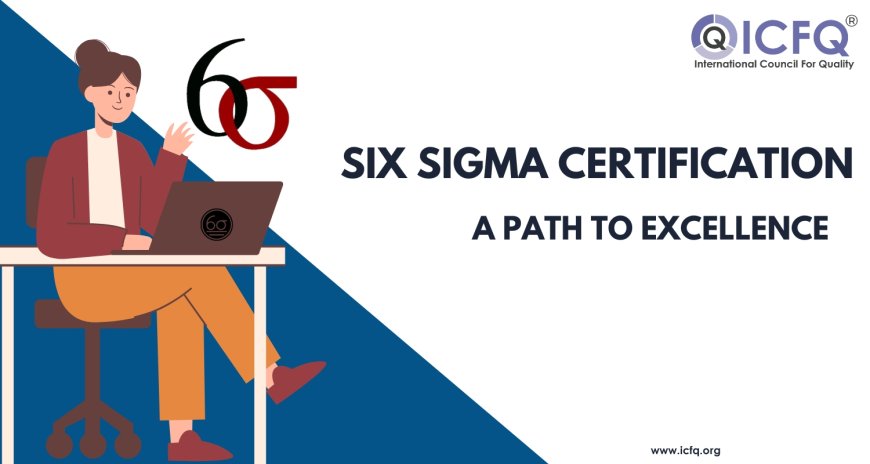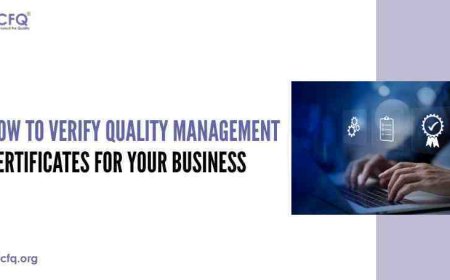Six Sigma Certification: A Path to Excellence
Get certified in Six Sigma to improve your success! Discover how it helps make things better and do more. Start now!

In today’s competitive business environment, professionals are constantly seeking ways to enhance their skills, improve their career prospects, and contribute to their organizations' success. One of the most sought-after qualifications for achieving these goals is Six Sigma certification. This certification validates an individual's expertise in Six Sigma methodologies, enabling them to lead quality improvement initiatives and drive operational excellence.
Despite the recognized benefits, many professionals are unsure about what Six Sigma certification entails, the different levels of certification available, and how to go about obtaining it. Additionally, organizations may struggle to identify which employees should be certified and how to integrate Six Sigma practices into their existing processes effectively. This uncertainty can hinder both individuals and businesses from realizing the full potential of Six Sigma.
To provide clarity, it is essential to address the following questions:
-
What is Six Sigma certification?
-
Why is Six Sigma certification important?
-
What are the different levels of Six Sigma certification?
-
How can one obtain Six Sigma certification?
-
What are the benefits of Six Sigma certification for individuals and organizations?
Let’s delve into each of these questions to provide a comprehensive understanding of Six Sigma certification and its significance.
What is Six Sigma Certification?
Six Sigma certification is a professional accreditation that demonstrates an individual's proficiency in Six Sigma principles and methodologies. It indicates that the certified individual has the knowledge and skills to identify defects in processes, reduce variability, and improve overall quality. The certification process typically involves rigorous training and an examination to ensure mastery of the Six Sigma tools and techniques.
Why is Six Sigma Certification Important?
Six Sigma certification is important for several reasons:
-
Professional Credibility: It enhances an individual's credibility and demonstrates their commitment to quality and process improvement.
-
Career Advancement: Certified professionals often have better career prospects, higher earning potential, and greater opportunities for leadership roles.
-
Organizational Impact: Certified individuals can lead Six Sigma projects that significantly improve operational efficiency and reduce costs.
-
Competitive Advantage: Organizations with certified Six Sigma professionals can gain a competitive edge by consistently delivering high-quality products and services.
What are the Different Levels of Six Sigma Certification?
Six Sigma certification is typically structured in a hierarchy of levels, each signifying a different depth of knowledge and expertise:
-
White Belt: This entry-level certification provides a basic understanding of Six Sigma concepts and methodologies. White Belts typically support project teams on a limited basis.
-
Yellow Belt: Yellow Belts have a more comprehensive understanding of Six Sigma principles and can assist in data collection and analysis. They often work as part of a project team.
-
Green Belt: Green Belts are proficient in Six Sigma tools and techniques and can lead smaller projects or support Black Belts in larger projects. They have a strong grasp of DMAIC methodology.
-
Black Belt: Black Belts have advanced knowledge of Six Sigma and are capable of leading complex projects. They mentor Green Belts and drive significant improvements within the organization.
-
Master Black Belt: This is the highest level of Six Sigma certification. Master Black Belts have extensive experience and expertise in Six Sigma and often play a strategic role in guiding the organization’s Six Sigma initiatives. They train and mentor Black Belts and other team members.

How Can One Obtain Six Sigma Certification?
Obtaining Six Sigma certification involves several steps:
-
Choose the Right Certification Level: Determine which certification level aligns with your career goals and current expertise.
-
Select a Reputable Training Provider: Enroll in a training program offered by a recognized and accredited organization. Popular providers include the American Society for Quality (ASQ), the International Association for Six Sigma Certification (IASSC), and various universities and professional training companies.
-
Complete the Training Program: Participate in the required training sessions, which may include classroom instruction, online courses, or a combination of both. Training programs cover Six Sigma principles, tools, and methodologies.
-
Pass the Certification Exam: Successfully pass the certification exam, which tests your knowledge and understanding of Six Sigma concepts. The exam format and difficulty vary by certification level and provider.
-
Gain Practical Experience: For higher certification levels (Green Belt and above), practical experience in leading or participating in Six Sigma projects is often required. This experience helps solidify your understanding and application of Six Sigma tools.
-
Maintain Certification: Some certification bodies require ongoing professional development to maintain certification. This may involve earning continuing education credits or participating in relevant activities.
What are the Benefits of Six Sigma Certification for Individuals and Organizations?
For Individuals:
-
Enhanced Skills: Certification provides a deep understanding of Six Sigma methodologies, enhancing problem-solving and process improvement skills.
-
Career Opportunities: Certified professionals are often preferred for roles in quality management, process improvement, and operational excellence.
-
Higher Earning Potential: Six Sigma certification can lead to higher salaries and better job positions due to the value and expertise it brings.
For Organizations:
-
Improved Quality: Certified employees can lead initiatives that improve product and service quality, leading to higher customer satisfaction.
-
Cost Reduction: By identifying and eliminating defects, organizations can reduce waste and operational costs.
-
Enhanced Efficiency: Streamlined processes and reduced variability lead to more efficient operations and better resource utilization.
-
Competitive Advantage: Organizations that embrace Six Sigma can outperform competitors by consistently delivering high-quality products and services.
Six Sigma certification is a valuable credential that can significantly impact both individuals and organizations. By providing a structured approach to process improvement and quality management, Six Sigma helps professionals enhance their skills and career prospects while enabling organizations to achieve operational excellence.
Whether you are an individual looking to advance your career or an organization seeking to improve your processes, Six Sigma certification offers a proven pathway to achieving your goals. By understanding the different levels of certification, the process to obtain it, and the benefits it brings, you can make informed decisions and take meaningful steps toward excellence.





























